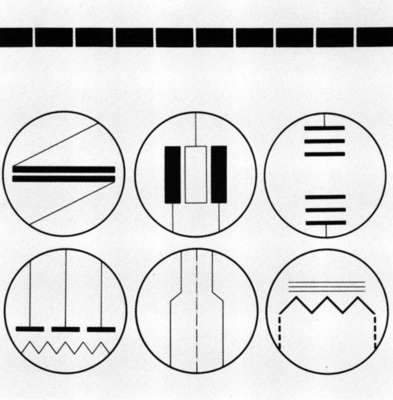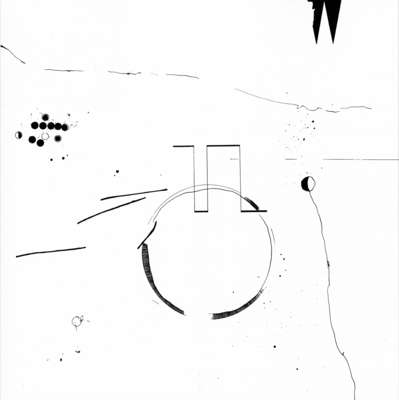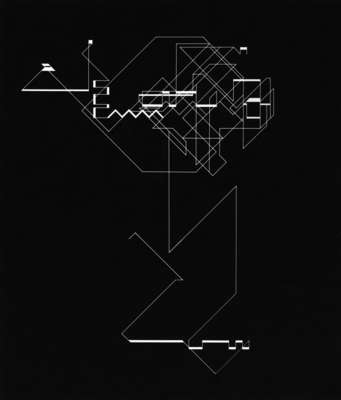| 1957-1961 |
Student at the School of Art and Crafts (gold- and silversmith, painting), in Pforzheim, Germany |
| 1959 |
Co-founder of a jazz club in a former butcher’s cellar in Pforzheim; he plays tenor saxophone and oboe for Hard-Bop-Group and Jazzgroup 60 |
| 1960 |
Creative work strongly influenced by Art Informel (action paintings) |
| 1961 |
Receives school prize (for art) of the City of Pforzheim |
| 1962 |
Decides exclusively to use only black and white in his pictures; develops a geometric pictorial language |
| 1963-1983 |
Moves to Paris, where he has his own studio |
| 1965 |
Student at the École des Beaux Arts, Paris (lithography).
His further geometric experiments lead him to Hard Edge painting which now defines his pictorial world |
| 1968 |
First one-man exhibition at the Daniel Templon Gallery, Paris.
He systematizes the image contents |
| 1969 |
First drawings with a computer. Learns programming and writes his first computer program: production of the first plotter drawing at the Meteorological Institute of Paris (Computing Center at Météorologie Nationale in Paris) after studying Max Bense’s Information Aesthetics and the possibilities of computer graphics.
Co-founder of the open seminar Art et Informatique at the Vincennes campus of Sorbonne (Université de Paris), Paris.
Meets his life-partner Estarose Wolfson.
Publication of his artist’s book Artificiata I |
| 1971 |
The Musée d’Art Moderne de la Ville de Paris (A-R-C) shows the exhibition ‘Manfred Mohr. Computer Graphics. Une esthétique programmée’. This represents the first recognition of computer-generated images in a one-man show exhibition held in a museum. |
| 1972 |
Sequencial computer drawings are introduced. Mohr’s artistic investigations into the cube begins; up to the present day, this has remained the key motif of all work groups, having passed through a development from the three- to multi-dimensional cube |
| 1973 |
Receives awards at the World Print Competition-73, San Francisco, and the 10th Biennial in Ljubljana |
| 1973-1976 |
Experiments in the first computer animations as a 16mm film |
| 1977 |
Investigation of the four-dimensional hypercube and Graph Theory. |
| 1980 |
Workphase: Divisibility, dissection of cube |
| 1981 |
Move to New York |
| 1982 |
Quasi-organic growth programs on the cube |
| 1987 |
First retrospective exhibition in the Wilhelm-Hack-Museum, Ludwigshafen, Germany.
Renews work on the 4-D hypercube. Four-dimensional rotation as generator of signs |
| 1988 |
Solo show at Reuchlin Museum Pforzeim. |
| 1989 |
Investigation of 5-D and 6-D hypercubes.
Rotation as well as projection as generators of signs |
| 1990 |
Receives the ‘Golden Nica’ at Prix Ars Electronica in Linz and the ‘Camille Graeser Prize’ in Zürich |
| 1991 |
Workphase: Laserglyphs, diagonal-paths through 6-D hypercube are cut from steel plates with a laser |
| 1997 |
Is elected a member of the group ‘American Abstract Artists’.
Receives an Artists’ Fellowship from New York Foundation for the Arts |
| 1998 |
Selected for Pioneering Artists, Siggraph Orlando, Florida. |
| 1998 |
Retrospective – Quadrat Bottrop, Josef Albers Museum, Bottrop. |
| 1999 |
Starts to use color (after using black and white for more than three decades) to show
the complexity of the work through differentiation. |
| 2001 |
Retrospective – Museum for Konkrete Kunst, Ingolstadt. |
| 2002 |
Extension of his artistic language to include moving pictures through the design and construction of small PCs for animation the program space.color. The resulting images are visualized in real time on LCD flat panels in a slow, non repetitive motion |
| 2004 |
Animation of the program subsets. |
| 2005 |
Museum im Kulturspeicher, Wurzburg. |
| 2006 |
Mohr receives the second d.velop digital art award (for digital pioneering- and original geometric research) [ddaa], organized annually by the DAM Berlin, and endowed by the d.velop AG in Gescher. |
| 2007 |
Retrospective – Grazyna Kulczyk Foundation, Poznan. |
| 2007 |
One-man exhibition at the Kunsthalle Bremen. |
| 2008 |
Retrospective – Kunstverein Pforzeim . |
| 2011 |
Parallel Resonance. [DAM] Cologne & Berlin + bitforms Gallery, New York. |

















